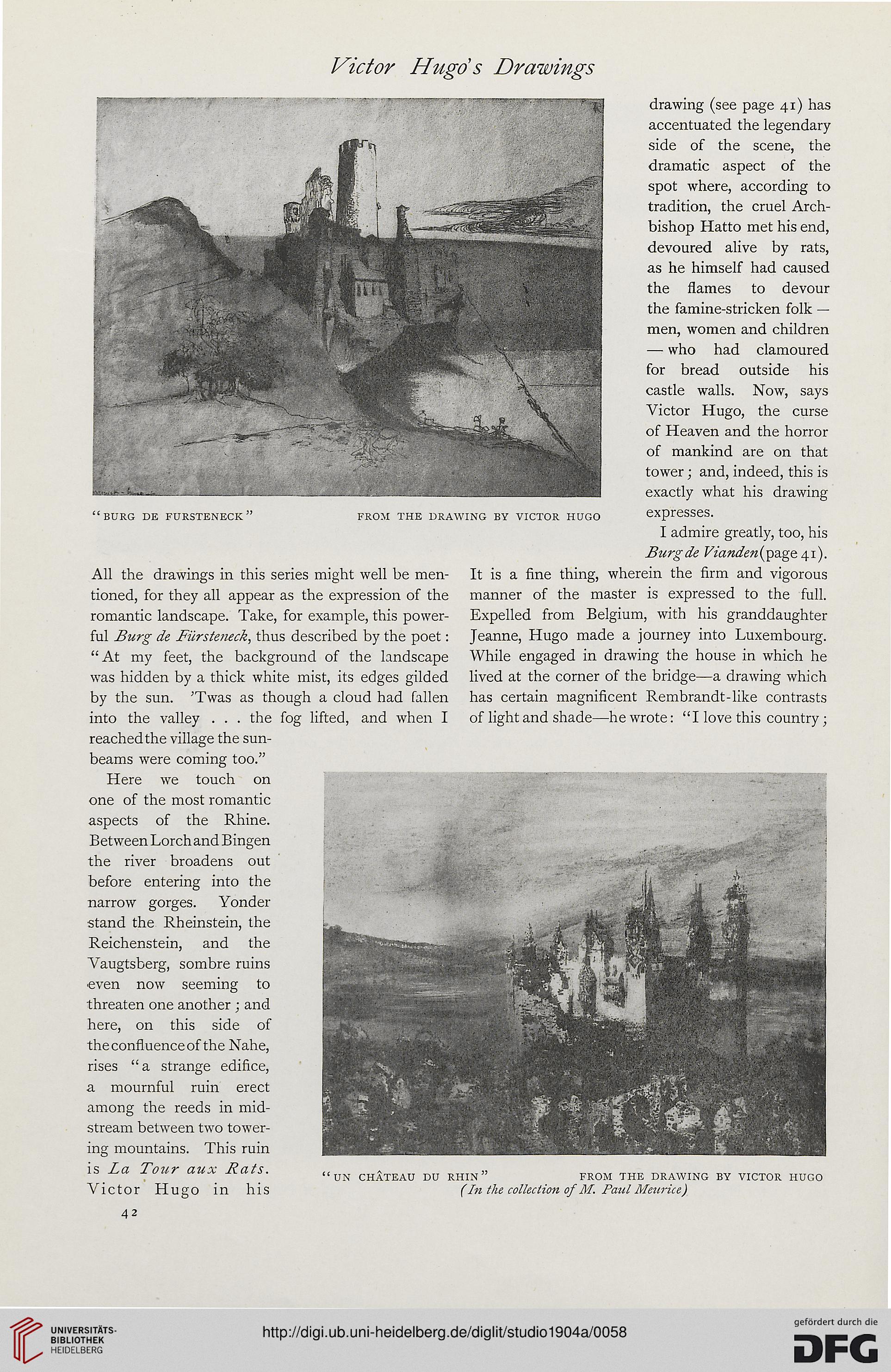Victor Hugo s Drawings
drawing (see page 41) has
accentuated the legendary-
side of the scene, the
dramatic aspect of the
spot where, according to
tradition, the cruel Arch-
bishop Hatto met his end,
devoured alive by rats,
as he himself had caused
the flames to devour
the famine-stricken folk —
men, women and children
— who had clamoured
for bread outside his
castle walls. Now, says
Victor Hugo, the curse
of Heaven and the horror
of mankind are on that
tower; and, indeed, this is
exactly what his drawing
"burg de fursteneck" from the drawing by victor hugo expresses.
I admire greatly, too, his
Burg de Vianden ( page 41).
All the drawings in this series might well be men- It is a fine thing, wherein the firm and vigorous
tioned, for they all appear as the expression of the manner of the master is expressed to the full,
romantic landscape. Take, for example, this power- Expelled from Belgium, with his granddaughter
ful Burg de Fursteneck, thus described by the poet: Jeanne, Hugo made a journey into Luxembourg.
"At my feet, the background of the landscape While engaged in drawing the house in which he
was hidden by a thick white mist, its edges gilded lived at the corner of the bridge—a drawing which
by the sun. 'Twas as though a cloud had fallen has certain magnificent Rembrandt-like contrasts
into the valley . . . the fog lifted, and when I of light and shade—he wrote: "I love this country;
reached the village the sun-
beams were coming too."
Here we touch on
one of the most romantic
aspects of the Rhine.
Between Lorch and Bingen
the river broadens out
before entering into the
narrow gorges. Yonder
stand the Rheinstein, the
Reichenstein, and the
Vaugtsberg, sombre ruins
■even now seeming to
threaten one another ; and
here, on this side of
the confluence of the Nahe,
rises " a strange edifice,
a mournful ruin erect
among the reeds in mid-
stream between two tower-
ing mountains. This ruin
is La Tour aux Rats. „un ch^teau du rhin" from the drawing by victor hugo
Victor Hugo in his (In the collection ofM. Paul Meurice)
42
drawing (see page 41) has
accentuated the legendary-
side of the scene, the
dramatic aspect of the
spot where, according to
tradition, the cruel Arch-
bishop Hatto met his end,
devoured alive by rats,
as he himself had caused
the flames to devour
the famine-stricken folk —
men, women and children
— who had clamoured
for bread outside his
castle walls. Now, says
Victor Hugo, the curse
of Heaven and the horror
of mankind are on that
tower; and, indeed, this is
exactly what his drawing
"burg de fursteneck" from the drawing by victor hugo expresses.
I admire greatly, too, his
Burg de Vianden ( page 41).
All the drawings in this series might well be men- It is a fine thing, wherein the firm and vigorous
tioned, for they all appear as the expression of the manner of the master is expressed to the full,
romantic landscape. Take, for example, this power- Expelled from Belgium, with his granddaughter
ful Burg de Fursteneck, thus described by the poet: Jeanne, Hugo made a journey into Luxembourg.
"At my feet, the background of the landscape While engaged in drawing the house in which he
was hidden by a thick white mist, its edges gilded lived at the corner of the bridge—a drawing which
by the sun. 'Twas as though a cloud had fallen has certain magnificent Rembrandt-like contrasts
into the valley . . . the fog lifted, and when I of light and shade—he wrote: "I love this country;
reached the village the sun-
beams were coming too."
Here we touch on
one of the most romantic
aspects of the Rhine.
Between Lorch and Bingen
the river broadens out
before entering into the
narrow gorges. Yonder
stand the Rheinstein, the
Reichenstein, and the
Vaugtsberg, sombre ruins
■even now seeming to
threaten one another ; and
here, on this side of
the confluence of the Nahe,
rises " a strange edifice,
a mournful ruin erect
among the reeds in mid-
stream between two tower-
ing mountains. This ruin
is La Tour aux Rats. „un ch^teau du rhin" from the drawing by victor hugo
Victor Hugo in his (In the collection ofM. Paul Meurice)
42




